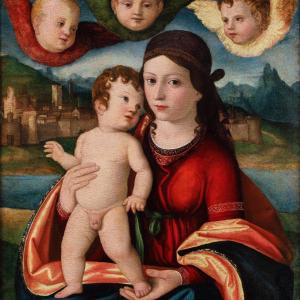PORTRAIT OF LOUISE MARIE DE LA GRANGE D'ARQUIN, MARQUISE DE BETHUNE IN POLISH COSTUME
Oil on canvas
67 x 53 cm / 26.4 x 20.9 inches, with frame 87 x 73 cm / 34.3 x 28.7 inches
PROVENANCE
France, private collection
For all lovers of Polish history, and more specifically the reign of King Jan III Sobieski, it is no secret how much influence his wife, Queen Maria Casimira de La Grange d'Arquien, had on the king. First, Maria Casimira came to Poland. Later, her two sisters arrived - Maria Anna, who became the wife of Chancellor Jan Wielopolski, and Louise Marie, who was the wife of the French ambassador in Warsaw, Marquis François Gaston de Béthune.
Thus, by a happy coincidence (spoiler - sarcasm), much of the Polish politics of Jan Sobieski's era was concentrated in the hands of the three sisters born de La Grange d'Arquien. One sister was the queen, the second the wife of the chancellor, and the third the wife of the French ambassador. While the iconography of the queen is well known, the portraits of her sisters are less well known. The portrait of Maria Anna is preserved in the collection of Wawel Castle, Kraków. A portrait of Louise Marie, attributed to Alexandre-François Desportes, is in the National Museum in Kielce. Two other portraits of her, containing extended inscriptions about the depicted person, are in France, one in a private collection, the other in the bureau du directeur at the Selles-sur-Cher hôpital.
Meanwhile, at the end of last year, a portrait appeared quite unexpectedly, which I managed to buy. The unknown woman was presented in a stylised Polish costume, and her face seemed familiar to me. Comparing her portraits with those of Louise Marie, I was convinced that I was looking at the same face. In the portraits in the French collections, Louise Marie was represented with a veil on her head (indicating her status as a widow, as the Marquis de Béthune died in 1692), while in our portrait, the Marquise is represented in a costume with a deep neckline, which refers rather to the period of her marital happiness. Perhaps the portrait was executed in Warsaw in the period around 1680, shortly after the birth of her daughter Joanna Maria (the future Princess Jablonowska, she became wife of Crown Chancellor Jan Stanislaw Jablonowski), when the French ambassador enjoyed the greatest prestige in Warsaw.

























 Le Magazine de PROANTIC
Le Magazine de PROANTIC TRÉSORS Magazine
TRÉSORS Magazine Rivista Artiquariato
Rivista Artiquariato
